
An unlikely choice for someone who generally prefers off the beaten track, but this was an opportunity to meet old friends in new places. One of the advantages with having lived and worked abroad is that you accumulate acquaintances from different parts of the world, who invite you to visit them, or, being of a like mind, travelling with them. They probably doubt you will take them up on this, of course, when airily issuing their invitations. We all do this in the enthusiasm of the moment.
One slight drawback with meeting up with others on different schedules is that one oft-times needs to organise one’s itinerary around their movements, and one’s initial plans may change substantially. Initially I was planning a cruise from Quebec City to Boston! However, a friend I used to work with, one of those academic types, always buzzing off to highfalutin events somewhere, was attending a conference at the UN in New York. At a similar time, my son and some Icelandic friends were due to be in Boston. So I decided to cross the pond and meet up with all of them.
Boston harbour
My hotel is at Boston’s Seaport. It is mid-afternoon, and I have been dropped off here by my greatest Icelandic pals after sojourning for a couple of days in their pad in Easton, a town full of grand parks and houses, wild turkeys and chipmunks – to name a few highlights. In benign and carefree mood, therefore, I set off for a little local exploration. I make for the water, as is my wont, and wander around Boston’s old wharves, which are paved with brick in zig-zag patterns. I reach Fan Pier and gaze across the expanse of water in the inner harbour. A cargo ship is crossing the harbour one way and a white Boston City cruise boat the other. Upon these wharves in olden times would have been loads of merchandise and sailing ships moored up alongside. Some 2D artworks in metal of these ships from different periods help the traveller to imagine what it was once like.
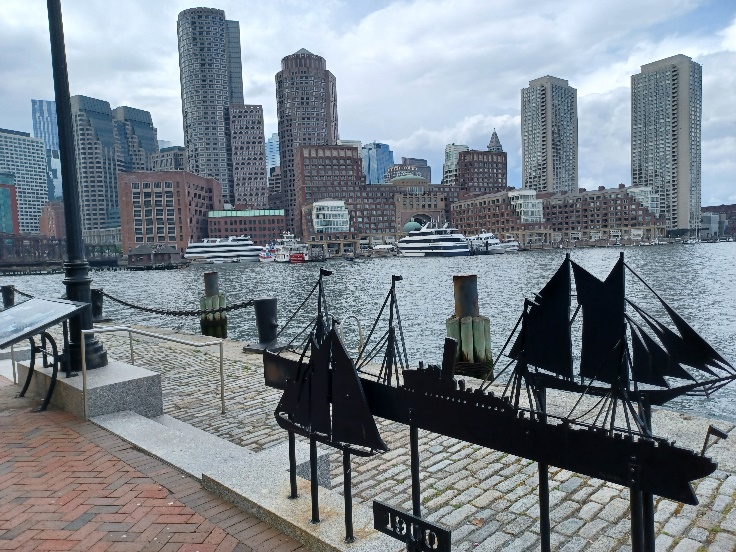
Behind me is the modern crescent shaped rusty coloured building of the John Joseph Moakley United States Courthouse with a large glass wall in the centre frontage and a rotunda on top. It has won a design award. As I continue, a giant milk bottle with a red lid appears. Around the bottom of the bottle are several red painted hatches through which are served ice-cream. Behind it, I soon discover, is the Children’s Museum.
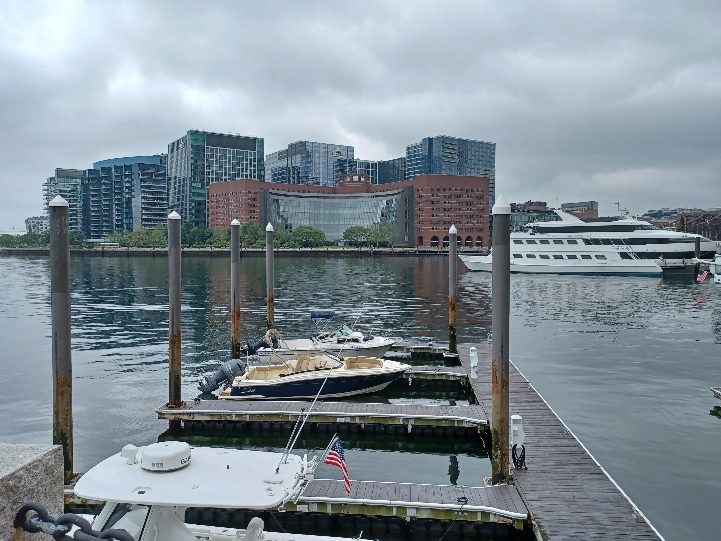
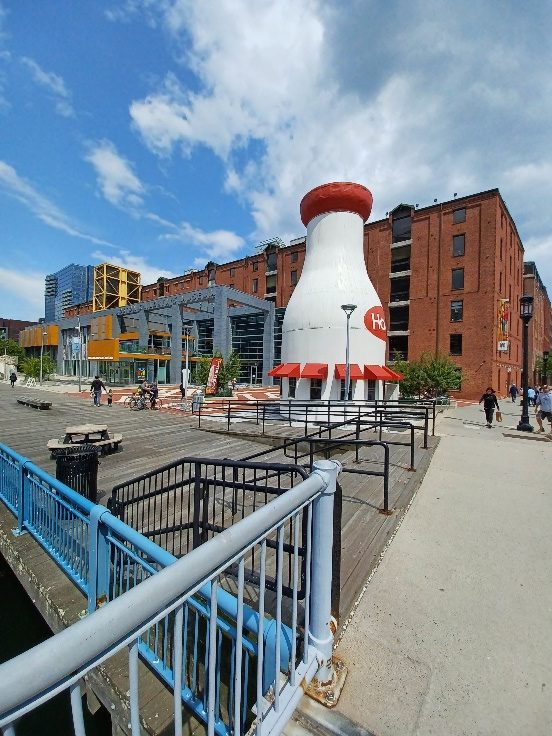
Boston Tea Party
On the wharf opposite are the rather more traditional museum buildings commemorating the Boston Tea Party in 1773. Red, white and blue banners on the jetty announce that it is the 250th anniversary of the event. Tied up alongside the wharf is a small replica of a sailing ship with lemon yellow coloured topsides and two masts. As I approach I see that the ship is called ‘Eleanor’, which was one of the three ships in Boston Harbour at that time, which had been loaded with tea from the East India Company. Ladies and gents in period costume reenact the occasion when the Sons of Liberty ‒ protesters against the tea act, which was imposed by the British parliament under Lord North ‒ boarded the ships and tipped over 300 chests of tea into Boston Harbour.
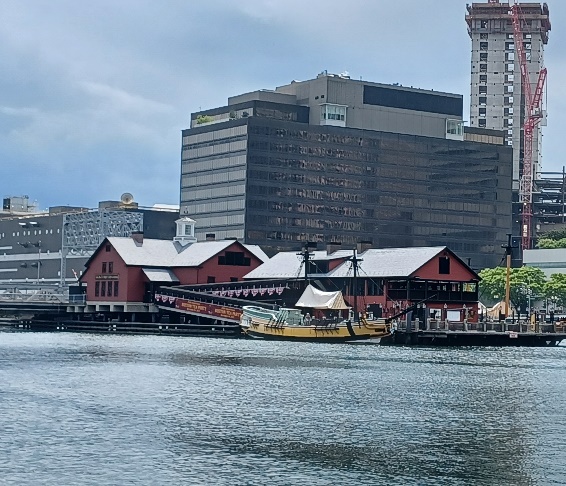
An information board informs me that the Government had granted exclusive rights to the East India Company, which was facing bankruptcy, to sell its tea in the colonies ‘without the usual tariffs’. But the colonists themselves were to pay duty on the tea. A letter at the time from one of them exhorts Americans not to purchase the tea. But it was thrown overboard, which prevented anyone who might perhaps be tempted to buy. The colonists, who had no representative in the British parliament, believed in the principle that there should be no taxation without representation. Clearly. And the Boston Tea Party was very significant in the lead up to the eventual American revolution against Great Britain. I suppose this is why we learned about it at school. One of the few things I remember from early history lessons.
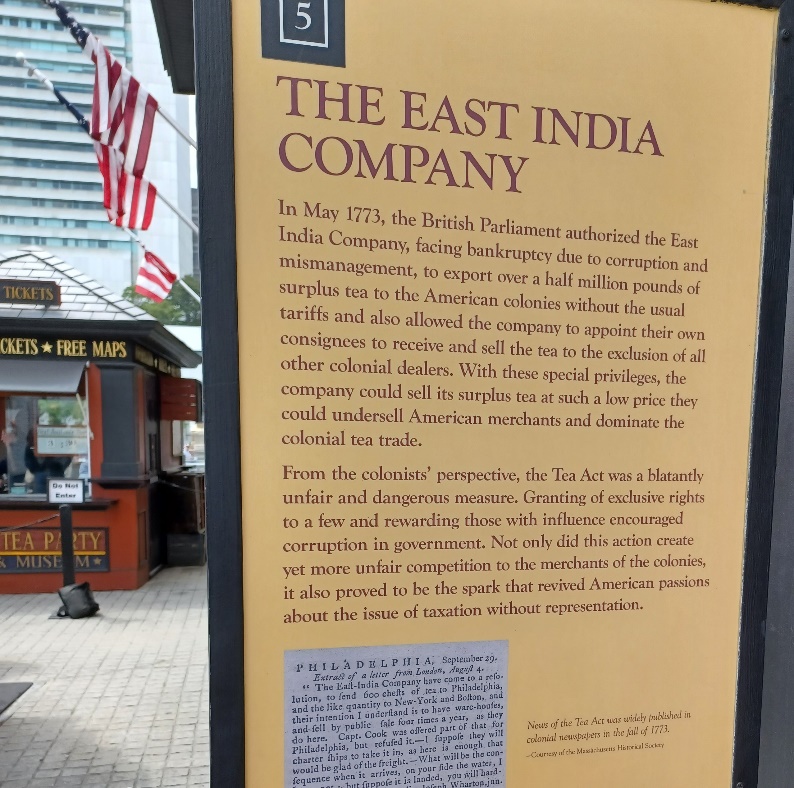
There is a largish tea shop inside the museum building with brass urns at one end from which one can fill one’s mug with a choice of several varieties of tea, and top up as often as required. Jolly good. I sit at a window overlooking ‘Eleanor’ with a large mug of tea and large slice of cake, after which I peruse the old photographs on the walls of the tea shop. There is a life-size sculpture here of one of the colonists’ militia – or minute men – three cornered hat on head, bearing a musket.
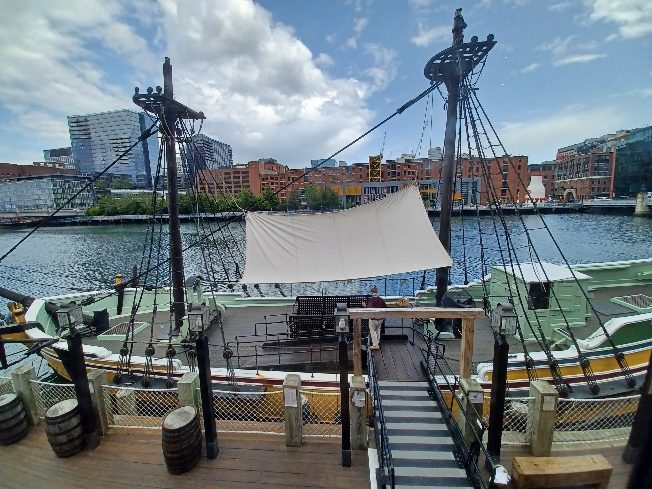
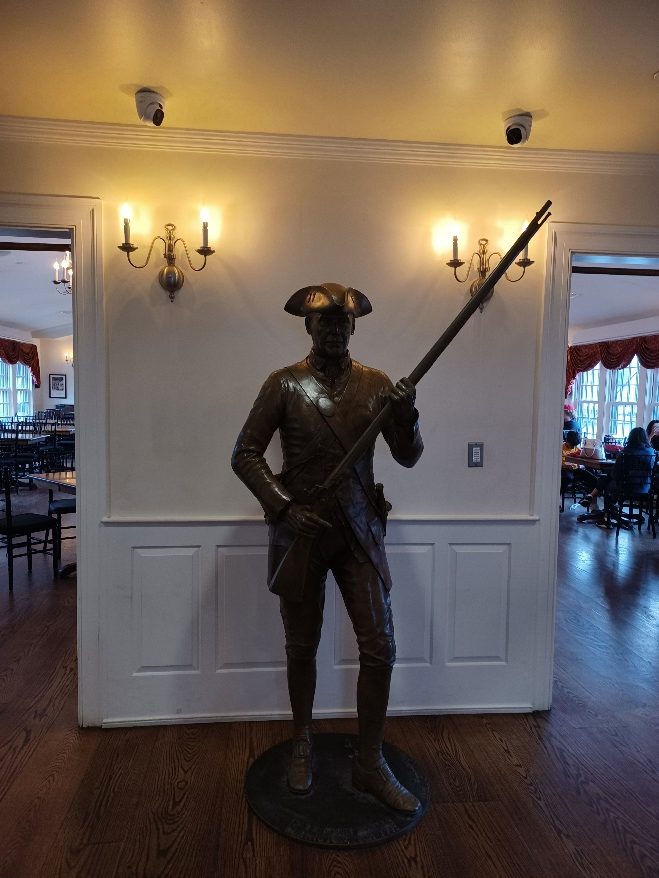
Boston Harbour Walk
My stroll continues next day past the Tea Party Museum and across Congress Bridge over the creek and up Atlantic Avenue. There are more wharves along here. Apartment blocks line the waterfront expensively. Fine buildings. I wander along the designated ‘Harbour Walk’ past a set of four large stainless steel sort of leaning panels. Against one of them a woman leans and sunbathes. A plaque informs me that this is an ‘untitled landscape’. OK. There are some sleek modern boats alongside the pontoons and, on the Long Wharf, large Boston City cruise boats. A bronze sculpture of dolphins leaping over the waves appears. A more traditional artwork. And a view of the Old Custom House pops up every now and then betwixt ginormous modern blocks. The Old Custom House was once the tallest building in Boston, now dwarfed both in stature and status. A man plays a saxophone in a small park named after Columbus, in front of which is an open air café with tables, benches and barrels surrounded by a wooden fence. Around it are flowers in tall flower pots.
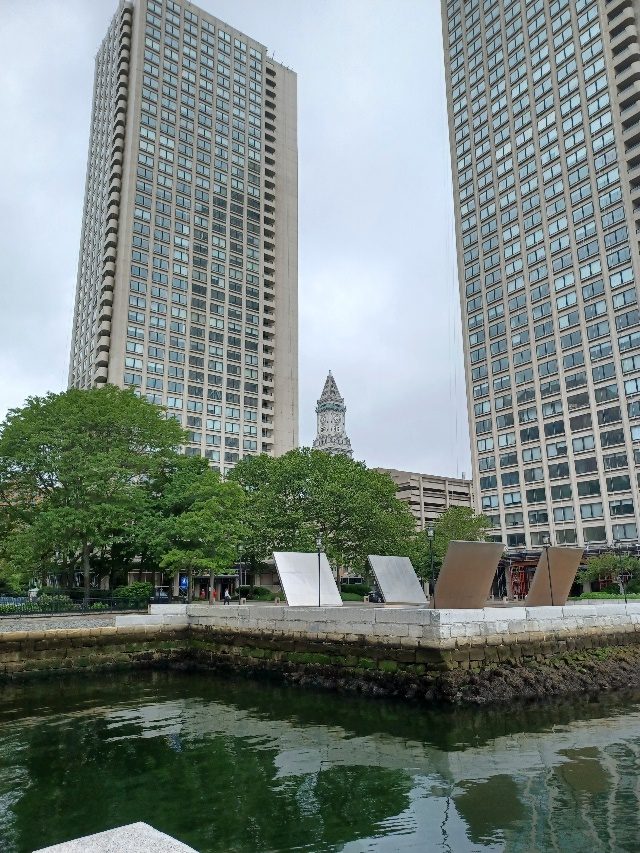
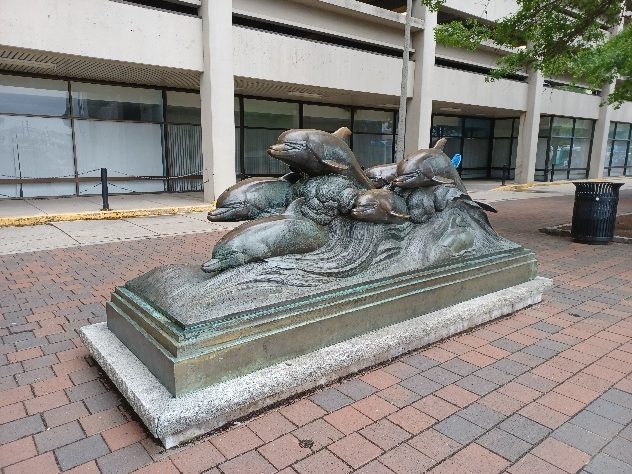
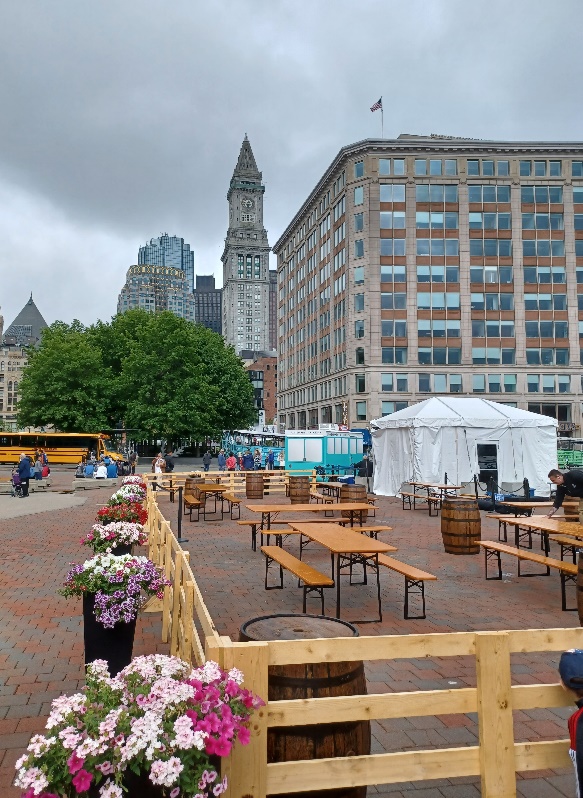
Old North Church
I continue to the North End of Boston and visit the bell tower in Old North Church. It is the M.I.T. (Massachusetts Institute of Technology) Guild of Bell Ringers’ practice morning. I climb up the narrow wooden steps, with its creaky boards, and am warmly welcomed. “Choose a bell”, says the tower captain. I ring with them. I am a novice ringer, having taken up this pastime as part of my retirement plan. I am not very good at it but it is fun. The bell tower has eight bells, which were hung in 1745 ‒ the first change ringing bells hung in the Americas. For those that don’t know, change ringing on bells began about 350 years ago in England. There are about 50 towers in the USA and Canada with active change ringing bands, versus about 5,000 in the UK. In change ringing, a group of ringers can ring the bells in different sequences. It’s a bit complicated to explain.
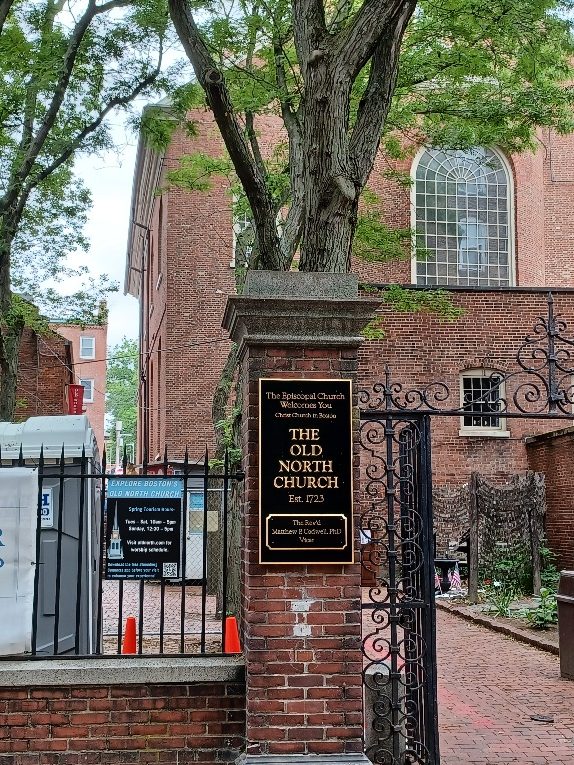
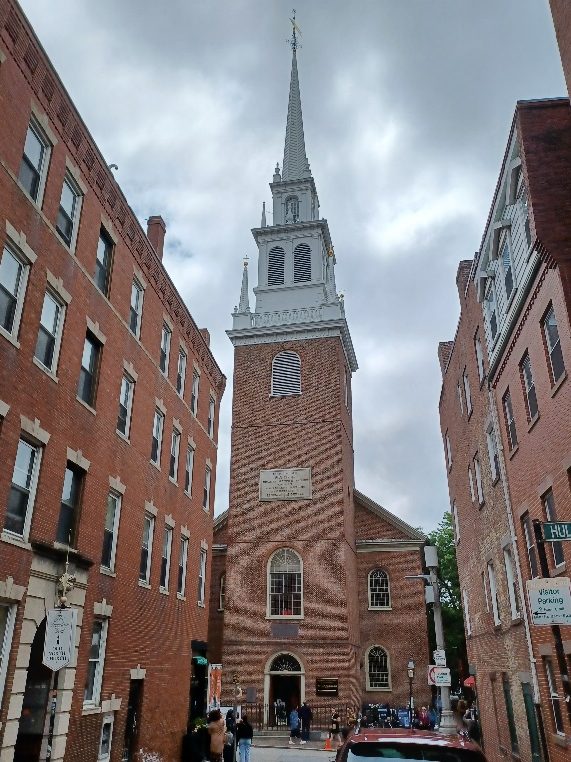
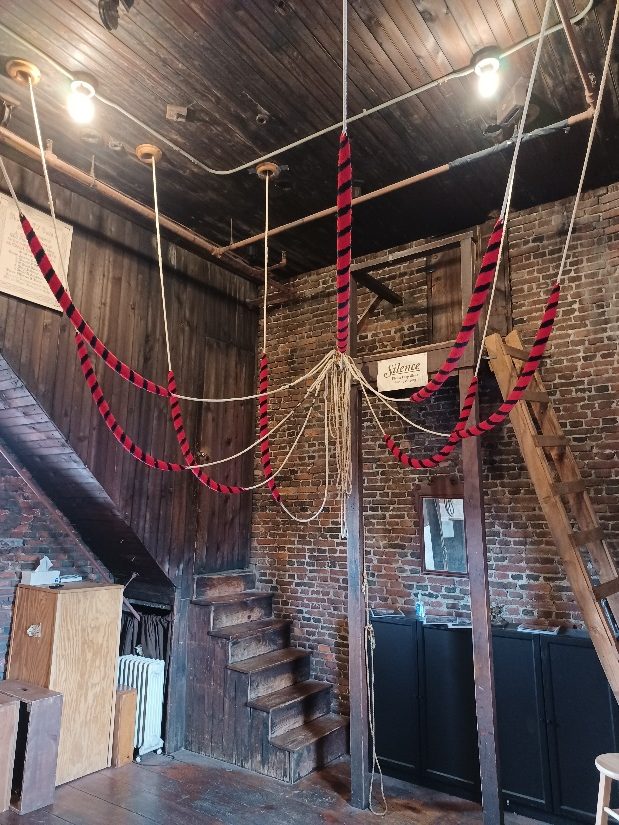
These bells witnessed an interesting event. Since the Boston Tea Party of 1773, there had been more revolts against British rule, and in 1775 the British regulars, the redcoats, were about to march on Concord in order to crush the militia. It was here in the Old North Church belfry where a lookout was placed to alert the colonists as to which way the redcoats were marching. Paul Revere, master propagandist, member of the Sons of Liberty, and protester against British rule, instructed his friend to hang one lantern in the belfry if the redcoats were marching on Concord by land and two lanterns if by water. On seeing the lanterns, he and others then galloped through the night to warn the militia of the impending arrival of the British. The militia then had time to prepare to repel them. The American poet, Henry Wadsworth Longfellow wrote a poem entitled ‘Paul Revere’s Ride’ in 1860, which begins thus:
“Listen, my children, and you shall hear
Of the midnight ride of Paul Revere,
On the eighteenth of April, in Seventy-Five:
Hardly a man is now alive
Who remembers that famous day and year.“
He said to his friend, “If the British march
By land or sea from the town to-night,
Hang a lantern aloft in the belfry-arch
Of the North-Church-tower, as a signal-light,—
One if by land, and two if by sea;
And I on the opposite shore will be,
Ready to ride and spread the alarm
Through every Middlesex village and farm,
For the country-folk to be up and to arm.”
Revere is waiting impatiently in Charlestown across the water with an eye on the bell tower. The poem describes this thus:
“But mostly he watched with eager search
The belfry-tower of the old North Church,
As it rose above the graves on the hill,
Lonely and spectral and sombre and still.
And lo! as he looks, on the belfry’s height,
A glimmer, and then a gleam of light!
He springs to the saddle, the bridle he turns,
But lingers and gazes, till full on his sight
A second lamp in the belfry burns!“
Paul Revere now knows that the British are coming over the water and thence towards Concord. Off he rides and warns every necessary person resulting in a rout of the Redcoats. It is a rousing poem, if somewhat inaccurate, and, after the exertions of ringing bells, I relax a while in a café and muse over this period in American history and the Old North Church tower’s part in it.
Freedom Trail: Founders Memorial
This afternoon I have arranged a tour along the ‘Freedom Trail’, a guided walk taking in the main sites of the American revolution against the British leading up to the Declaration of American independence on 4th July, 1776. My son is joining me. A happy coincidence that he happens to be in the area at the same time. The tour group meets at the 300th Anniversary monument, ‘The Founders Memorial’, which was installed in 1930 on the edge of Boston Common. The granite monument has upon it a bronze relief which depicts the founding of Boston in 1630. It portrays two men, John Winthrop and William Blaxton, in their cloaks and hats shaking hands, and scantily clad native Americans, who resided here before the colonists’ arrival, crouching in the corner. A woman stands on the right. I am not sure what she is doing. A sailing ship lies peacefully at anchor in the bay and some sailors are hauling boats up the beach.
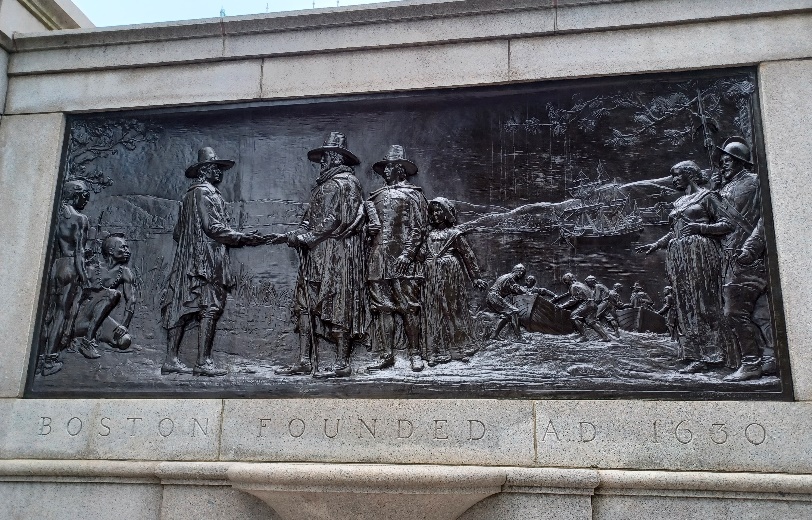
The monument faces the Common, on which, today, a Pride rally is underway. Behind the monument are the last remnants of the Boston Pride parade. One or two floats are still filing along Beacon Street, which runs along the Common’s edge, while other floats seem to have been abandoned on the roadside. This is the first time since the Covid pandemic that this parade and festival, celebrating the LGBTQ community, has taken place. Attendance is high. Opposite the Common, a bit further along, is the grandiose Massachusetts State House with its golden dome. With its pomp and columns and flags, it houses the government for the state of Massachusetts. An equestrian statue of the Civil War General, Joseph Hooker, sits stern and upright on one side, while statues of other worthies, including past president, John F. Kennedy, stand directly in front. Various groups of people have petitioned for their rights within this building. An appropriate location then for the LGBTQ gathering.
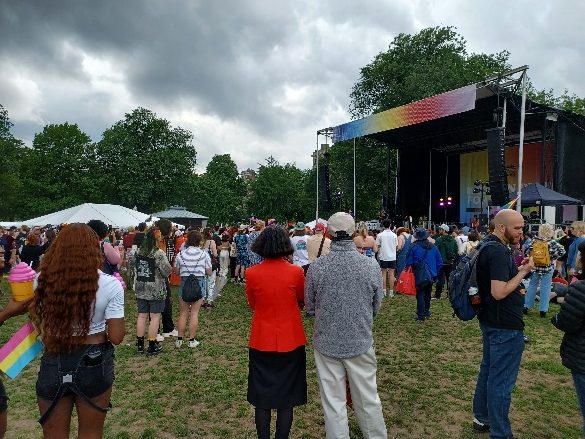
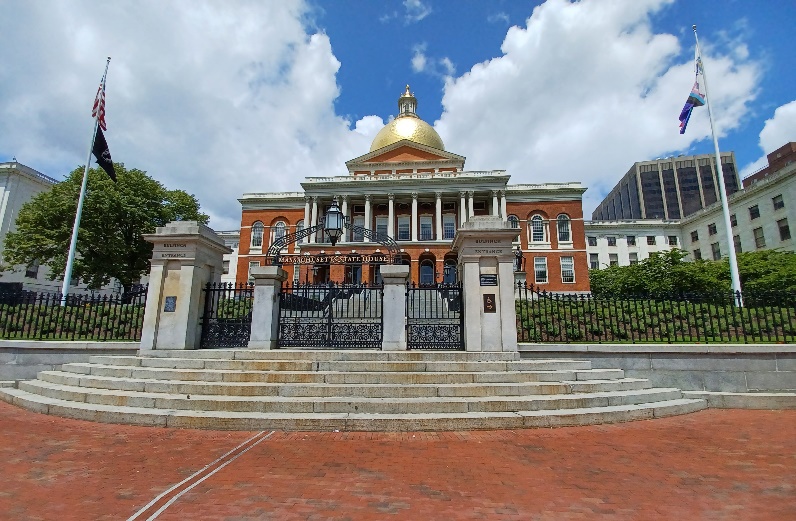
The moment the tour of the Freedom Trail begins the heavens open. It doesn’t seem to dampen the spirits of the Pride participants but there is a mass exodus, people with painted rainbow stripes on bellies, brollies and balloons departing every which way. The entertainment continues under a covered stage, however. Lots of noise. A partial shelter for the small but ever diminishing tour group is provided by a few trees but the rain is so heavy that the water filters fast between the branches. A brave policeman directs traffic along Beacon street, and soggy people across the pedestrian crossing. We are soaked through. There are only three participants left on the tour now, my son and I and an Australian, plus the guide with his ginger beard, moustache and side burns. His soft cap, waistcoat, jacket and corduroys are likewise soaked and his laminated information sheets stuck together. Unfazed and stoical, he begins. After all, he cannot abandon a tour group just because of a bit of rain.
Granary Burying Ground
As we squelch our way through the puddles along the Freedom Trail the deluge continues. Thank goodness for my sun hat. We visit the Granary Burying Ground where Paul Revere, Samuel Adams and other patriots and members of the Sons of Liberty are buried, along with the five victims of the 1770 Boston Massacre, in which British soldiers who were being harassed, fired upon the crowd. An American flag is stuck in the ground in front of Adams’ gravestone. “Samuel Adams founded the Sons of Liberty”, our guide tells us. “And he was one of the signatories to the Declaration of Independence”. He was also one of the delegates to the Continental Congress, which decided on the form of the national flag in 1777, which became known as the ‘Stars and Stripes’. The thirteen stripes on the flag represent the thirteen original colonies. The number of stars representing each state has changed over the years but is now 50. Adams became the Governor of Massachusetts in 1794.
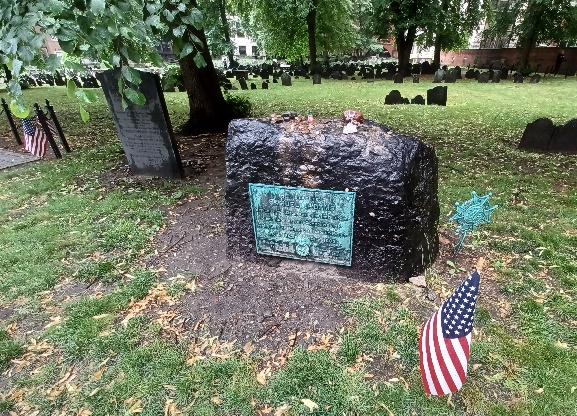
The rain has been pouring relentlessly but, at last, it stops. I squeeze out water from the back of my coat. Historical landmarks are commented on in depth by our guide. We pass the Old South Meeting House, an old church with a tall cream coloured steeple and large clock. It was here where organisers of the Boston Tea Party met, we are told. We pause in front of the Old State House, an old brick building with a cream painted balcony. It was in front of this building where the Boston Massacre took place. The Declaration of Independence was announced to Bostonians from this same balcony. “Your late Queen Elizabeth II addressed a crowd from here during a visit in 1976”, says our guide. “To celebrate 200 years of independence”. We pass Quincy market and stop at Faneuil Hall, where Samuel Adams and other patriots made speeches. It is a grand brick building of three stories with a cupola on top. Outside it someone is selling balloons, the long narrow ones in funny shapes, alongside drinks stalls.
The tour takes in the Old North Church where I rang the bells earlier. “Paul Revere didn’t actually make it through that night”, we are told. Oh? “He was captured by a British patrol, but one of the other riders did”. Even so the great night ride is attributed to him. Revere was a silversmith by trade, as well as an artist and engraver. He later turned to iron and bronze casting and cast the large bronze bell in St Stephen’s Church, according to our guide. Not the ones in Old North Church though. He was too young then. They were cast in London by Rudhall in 1744. There is a large statue of Revere on his horse in a little plaza between these two churches. His house is nearby.
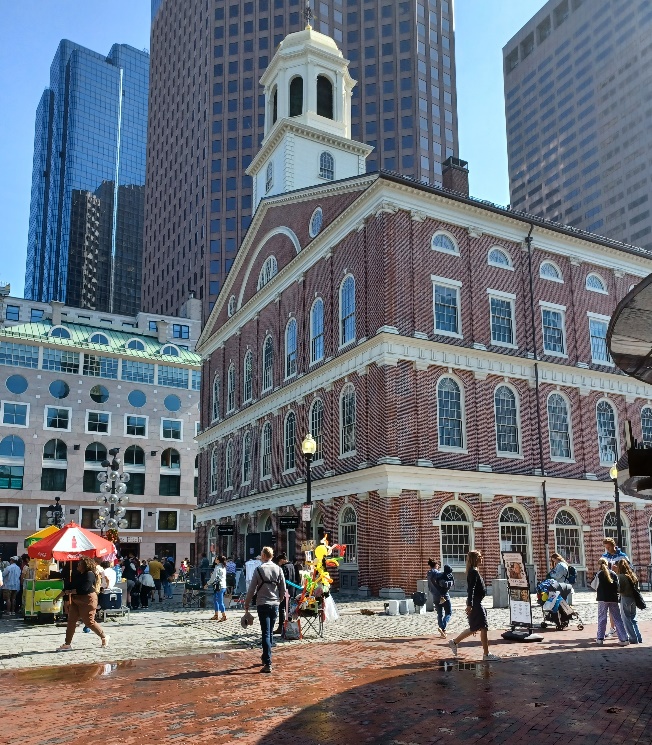
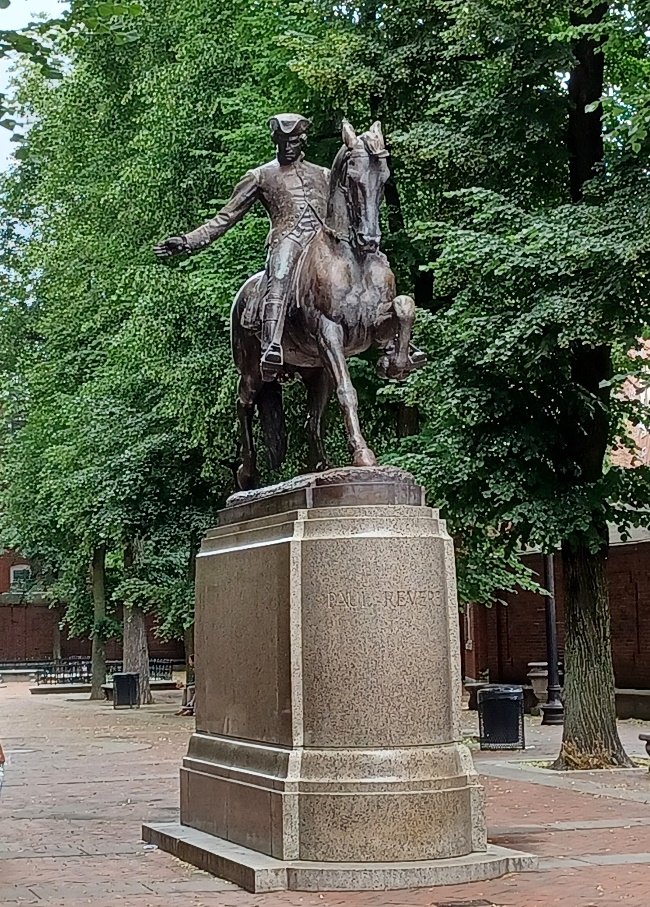
The Freedom Trail tour ends on Copp’s Hill Terrace up the hill from the Old North Church. My son has a long conversation with the guide while I stand in the emerging sunshine to dry out a bit, looking down upon the Charles River and the Charlestown Navy Yard in the distance.
A beautiful schooner is motoring in to one of the marinas as we walk back. People are watching from the wharf. Its name is ‘Liberty Star.’ Technically it is a gaff rigged topsail schooner, one of a fleet of boats run by the Liberty Fleet of Tall Ships. Its wooden hull is green painted with white above and white sails. I wouldn’t mind having a sail on this vessel, I muse. No time though on this trip. We have to get back to the hotel and change from our sodden clothes into something more suitable for this evening’s entertainment: a baroque opera, ‘Circe’, by Henry Desmarest. Never heard of this composer before. One of those lesser known works, it is part of the programme in this year’s Boston Early Music Festival, which has been producing annual programmes of concerts since its founding in 1980. It is all great fun with colourful costumes and splendid music within the decorated interior of the Emerson Cutler Majestic Theatre. A fitting end to a day of diverse activities in this old city.
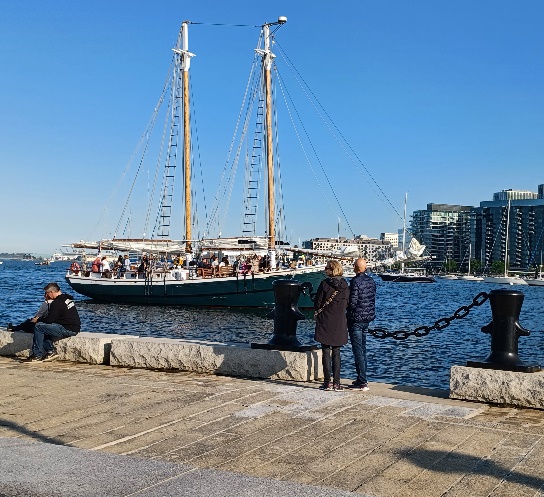

Leave a Reply